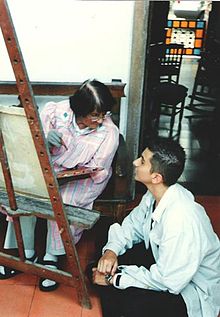Débora Arango
Débora Arango Pérez (born November 11, 1907 in Medellín , Colombia , † December 4, 2005 in Envigado ) was a Colombian painter and ceramist .
life and work
After graduating from the Maria Auxiliadora School in Copacabana , a suburb of Medellín , Arango began studying painting at the Institute of Fine Arts in Medellín, which she dropped out after two years because of the conventional nature of the training. As a student of Pedro Nel Gómez , she first took part in a joint exhibition in 1937, which featured a number of oils and watercolors, as well as some scandalous nudes. Two years later she won first prize in an exhibition organized by the Society of Friends of the Arts at Club Unión de Medellín. In 1940 she had her first solo exhibition at the Teatro Colón de Santa Fé in Bogotá and later took part in the annual Salon of Colombian Artists. She later showed her work in other collective exhibitions in the cities of Cali and Medellin, where her paintings aroused such rejection that her excommunication was demanded. In the 1940s, at least in Colombia, few artists presented political and social criticism through their art to the extent that Arango did. She commented not only on the political and social situations, but was also instrumental in portraying the plight of ordinary women in Colombian society at that time. From 1946 she became interested in the fresco technique and studied the work of some Mexican watercolorists. She also toured Mexico, the United States, Spain, England, Scotland, France, and Austria. In Mexico she worked with Diego Rivera , David Siqueiros and other Mexican wall painters. In 1955 a solo exhibition was shown in Spain at the Madrid Hispanic Culture Institute ; after the first day of the exhibition, all of her paintings were removed without explanation by order of the authorities. This motivated her immediate return to Medellín, where she exhibited a range of ceramics at the Colombo-American Center that same year. In 1947 she made only one mural in Medellín, which is one of her most outstanding works. Throughout her career, Arango used her artwork to tackle a wide variety of politically charged and controversial topics, from naked women to the role of the Roman Catholic Church to dictatorships. In 2003 she was awarded the Cruz de Boyacá, the highest honor in Colombia. On November 29, 2016, the Bank of the Republic of Colombia put a banknote with the image of the artist Débora Arango into circulation.
Exhibitions (selection)
- 1940: Salón Nacional de Artistas; Bogotá , Colombia
- 1944: Exposición Nacional de Medellín; Colombia
- 1984: Biblioteca Luis Ángel Arango; Bogotá, Colombia
- 1984: Museo de Arte Moderno; Medellin, Colombia
literature
- Ángel Galeano H .: Débora Arango: El Arte, Venganza Sublime, Panamericana, 2005, ISBN 978-9583015144
Web links
| personal data | |
|---|---|
| SURNAME | Arango, Débora |
| ALTERNATIVE NAMES | Arango Pérez, Débora |
| BRIEF DESCRIPTION | Colombian painter and ceramist |
| DATE OF BIRTH | November 11, 1907 |
| PLACE OF BIRTH | Medellin , Colombia |
| DATE OF DEATH | 4th December 2005 |
| Place of death | Envigado |

